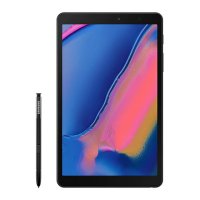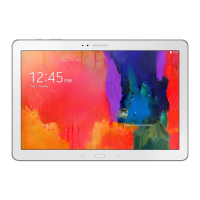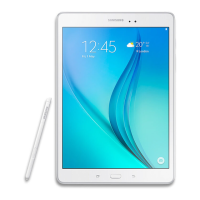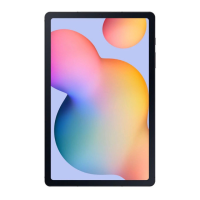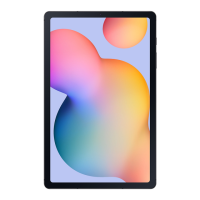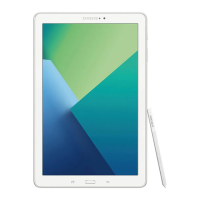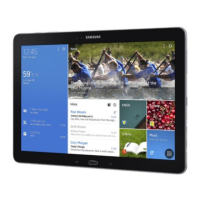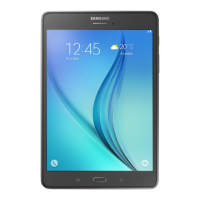Do you have a question about the Samsung SM-P200 and is the answer not in the manual?
Important preliminary information and guidelines for using the device safely.
Explanation of symbols used in the manual to convey warnings, cautions, and notices.
Guidelines to prevent device overheating and potential damage.
Advice on using the device in various environmental conditions to avoid damage.
List of items included in the device packaging.
Visual identification of external components and ports on the device.
Important warnings and advice regarding the care and use of device components.
Description of physical buttons like Power and Volume keys and their functions.
Explanation of on-screen navigation buttons (Recents, Home, Back).
Introduction to the S Pen, its components, and basic functions.
Instructions on how to replace a worn-out S Pen nib.
Steps and precautions for charging the device's battery.
Tips and settings to conserve battery power and extend usage time.
Step-by-step guide for inserting the SIM or USIM card into the device.
Instructions for inserting a microSD card for expandable storage.
Procedure for safely removing the microSD card from the device.
Basic instructions for powering the device on, off, and restarting.
Guide through the initial configuration steps after turning on the device.
Creating, signing in, finding ID, resetting password, and removing your Samsung account.
Using Smart Switch to transfer data from a previous device to the new one.
Methods for transferring data between devices using Wi-Fi Direct.
Procedures for backing up and restoring data using external storage or computers.
Guidelines for interacting with the touchscreen and avoiding damage.
Explanation of various touch gestures like tap, drag, swipe, and pinch.
Description of the on-screen navigation buttons and their functions.
How to navigate between the Home screen and the Apps screen.
Steps to organize apps into folders on the Home or Apps screen.
Basic information about the device's lock screen functionality.
Options for setting up screen lock types like PIN, pattern, or password.
Accessing and using quick setting toggles for features like Wi-Fi, Bluetooth.
Overview of the on-screen keyboard and its layout.
How to copy, cut, and paste text using the device's keyboard.
Information on browsing and downloading apps from the Galaxy Store.
Information on browsing and downloading apps from the Google Play Store.
How to remove or disable applications from the device.
How to search for content on the device using the Finder feature.
Accessing S Pen features and apps through the Air command panel.
Creating quick notes using the S Pen and the Air command panel.
Using S Pen to select areas for extraction, GIF creation, or other actions.
Capturing screenshots and annotating them with the S Pen.
Instructions for initiating and receiving voice and video calls.
How to block unwanted incoming calls from specific numbers.
Methods for adding contacts from the keypad or call logs.
Adding contacts from other storage locations or accounts.
Options for sharing contact information with others.
Composing and sending text messages, including voice messages.
How to block unwanted messages from specific senders.
Steps for navigating websites, bookmarking, and managing tabs.
Activating and using the secure, private browsing mode.
Configuring email accounts to send and receive emails on the device.
Procedures for composing, sending, and viewing emails.
Guide to capturing still images, including focus and brightness adjustments.
How to choose between wide-angle and telephoto lenses for shooting.
Taking photos with a blurred background effect for portraits.
Adjusting focus and exposure independently on the camera screen.
Capturing wide-angle photos by stitching multiple images together.
Accessing and viewing photos stored on the device.
Playing and managing video files stored on the device.
How to remove unwanted photos and videos from the device.
Running two apps simultaneously in a split-screen layout.
Using apps in floating pop-up windows for multitasking.
Accessing support, community features, and news from Samsung.
Introduction to creating and managing notes with text and handwriting.
Tips and tools for writing and drawing notes using the S Pen.
Overview of PENUP for sharing artwork and learning drawing techniques.
Steps to upload and share your creative works on PENUP.
Learning to draw by following step-by-step video tutorials.
Adding events, setting reminders, and managing your schedule.
Setting up task reminders with time or location-based alerts.
Connecting your tablet and smartphone for seamless interaction.
Pairing your tablet with your smartphone using Bluetooth and Wi-Fi Direct.
Accessing and managing files stored on the device and cloud services.
Setting, stopping, and managing alarms using the Clock app.
Using the World Clock for different time zones and the Stopwatch for timing.
Accessing Bixby Home for personalized content and recommendations.
Customizing the content displayed on the Bixby Home screen.
How to launch and begin using the Reminder feature.
Creating, completing, restoring, and deleting reminders.
Setting up a safe and fun environment for children using the device.
Configuring usage limits and monitoring activity within Samsung Kids.
Controlling and managing smart appliances and IoT devices with your tablet.
Connecting Bluetooth headsets and wearable devices to your tablet.
Organizing and controlling smart devices based on their physical location.
Using the tablet as a digital bulletin board while charging.
Configuring and viewing slideshows of favorite images on Daily Board.
Customizing Daily Board features like slideshow, clock, and memo.
Searching for information and browsing the internet using the Chrome browser.
Sending and receiving emails through the Gmail service.
Finding locations, searching maps, and viewing location information.
Watching and creating videos, and sharing them with others.
Searching, managing, and editing photos and videos from various sources.
Changing settings for Wi-Fi, Bluetooth, and mobile networks.
Connecting to Wi-Fi networks and managing network settings.
Connecting devices directly via Wi-Fi without an access point.
Pairing and connecting with other Bluetooth-enabled devices.
Adjusting volume, ringtones, notification sounds, and vibration patterns.
Enhancing audio quality with surround sound effects.
Adjusting brightness, font size, screen zoom, and timeout settings.
Applying a dark theme to reduce eye strain and save battery.
Setting up images to display when the device is idle or charging.
Changing the background image for the Home and Lock screens.
Configuring lock screen elements like clock style and notifications.
Setting up automatic device unlocking based on trusted locations or devices.
Configuring security features like Face Recognition and Google Play Protect.
Setting up and using facial recognition for device unlock.
Step-by-step guide to accurately register your face for recognition.
Creating a secure, separate storage area for private content and apps.
Transferring files and apps into the secure storage.
Managing app permissions, diagnostic data, and marketing preferences.
Controlling location access permissions for apps and services.
Managing Samsung/Google accounts and backing up device data.
Setting up and managing additional user accounts on the device.
Activating and configuring advanced device functionalities.
Using device movements for shortcuts like double-tap to wake or palm swipe.
Monitoring device usage and setting parental restrictions for children.
Limiting daily usage time for specific applications.
Improving performance by closing background apps and scanning for issues.
Checking battery status, managing power modes, and optimizing usage.
Checking storage status and managing device memory and files.
Adding and setting preferred languages for the device interface.
Accessing help and configuration information for the device and apps.
Viewing device status, legal, software, and battery information.
Resolving issues related to password, PIN, and PUK code entry.
Troubleshooting poor reception or service-related error messages.
Resolving problems with slow or improper touchscreen response.
Solutions for when the device freezes, hangs, or encounters critical errors.
Important preliminary information and guidelines for using the device safely.
Explanation of symbols used in the manual to convey warnings, cautions, and notices.
Guidelines to prevent device overheating and potential damage.
Advice on using the device in various environmental conditions to avoid damage.
List of items included in the device packaging.
Visual identification of external components and ports on the device.
Important warnings and advice regarding the care and use of device components.
Description of physical buttons like Power and Volume keys and their functions.
Explanation of on-screen navigation buttons (Recents, Home, Back).
Introduction to the S Pen, its components, and basic functions.
Instructions on how to replace a worn-out S Pen nib.
Steps and precautions for charging the device's battery.
Tips and settings to conserve battery power and extend usage time.
Step-by-step guide for inserting the SIM or USIM card into the device.
Instructions for inserting a microSD card for expandable storage.
Procedure for safely removing the microSD card from the device.
Basic instructions for powering the device on, off, and restarting.
Guide through the initial configuration steps after turning on the device.
Creating, signing in, finding ID, resetting password, and removing your Samsung account.
Using Smart Switch to transfer data from a previous device to the new one.
Methods for transferring data between devices using Wi-Fi Direct.
Procedures for backing up and restoring data using external storage or computers.
Guidelines for interacting with the touchscreen and avoiding damage.
Explanation of various touch gestures like tap, drag, swipe, and pinch.
Description of the on-screen navigation buttons and their functions.
How to navigate between the Home screen and the Apps screen.
Steps to organize apps into folders on the Home or Apps screen.
Basic information about the device's lock screen functionality.
Options for setting up screen lock types like PIN, pattern, or password.
Accessing and using quick setting toggles for features like Wi-Fi, Bluetooth.
Overview of the on-screen keyboard and its layout.
How to copy, cut, and paste text using the device's keyboard.
Information on browsing and downloading apps from the Galaxy Store.
Information on browsing and downloading apps from the Google Play Store.
How to remove or disable applications from the device.
How to search for content on the device using the Finder feature.
Accessing S Pen features and apps through the Air command panel.
Creating quick notes using the S Pen and the Air command panel.
Using S Pen to select areas for extraction, GIF creation, or other actions.
Capturing screenshots and annotating them with the S Pen.
Instructions for initiating and receiving voice and video calls.
How to block unwanted incoming calls from specific numbers.
Methods for adding contacts from the keypad or call logs.
Adding contacts from other storage locations or accounts.
Options for sharing contact information with others.
Composing and sending text messages, including voice messages.
How to block unwanted messages from specific senders.
Steps for navigating websites, bookmarking, and managing tabs.
Activating and using the secure, private browsing mode.
Configuring email accounts to send and receive emails on the device.
Procedures for composing, sending, and viewing emails.
Guide to capturing still images, including focus and brightness adjustments.
How to choose between wide-angle and telephoto lenses for shooting.
Taking photos with a blurred background effect for portraits.
Adjusting focus and exposure independently on the camera screen.
Capturing wide-angle photos by stitching multiple images together.
Accessing and viewing photos stored on the device.
Playing and managing video files stored on the device.
How to remove unwanted photos and videos from the device.
Running two apps simultaneously in a split-screen layout.
Using apps in floating pop-up windows for multitasking.
Accessing support, community features, and news from Samsung.
Introduction to creating and managing notes with text and handwriting.
Tips and tools for writing and drawing notes using the S Pen.
Overview of PENUP for sharing artwork and learning drawing techniques.
Steps to upload and share your creative works on PENUP.
Learning to draw by following step-by-step video tutorials.
Adding events, setting reminders, and managing your schedule.
Setting up task reminders with time or location-based alerts.
Connecting your tablet and smartphone for seamless interaction.
Pairing your tablet with your smartphone using Bluetooth and Wi-Fi Direct.
Accessing and managing files stored on the device and cloud services.
Setting, stopping, and managing alarms using the Clock app.
Using the World Clock for different time zones and the Stopwatch for timing.
Accessing Bixby Home for personalized content and recommendations.
Customizing the content displayed on the Bixby Home screen.
How to launch and begin using the Reminder feature.
Creating, completing, restoring, and deleting reminders.
Setting up a safe and fun environment for children using the device.
Configuring usage limits and monitoring activity within Samsung Kids.
Controlling and managing smart appliances and IoT devices with your tablet.
Connecting Bluetooth headsets and wearable devices to your tablet.
Organizing and controlling smart devices based on their physical location.
Using the tablet as a digital bulletin board while charging.
Configuring and viewing slideshows of favorite images on Daily Board.
Customizing Daily Board features like slideshow, clock, and memo.
Searching for information and browsing the internet using the Chrome browser.
Sending and receiving emails through the Gmail service.
Finding locations, searching maps, and viewing location information.
Watching and creating videos, and sharing them with others.
Searching, managing, and editing photos and videos from various sources.
Changing settings for Wi-Fi, Bluetooth, and mobile networks.
Connecting to Wi-Fi networks and managing network settings.
Connecting devices directly via Wi-Fi without an access point.
Pairing and connecting with other Bluetooth-enabled devices.
Adjusting volume, ringtones, notification sounds, and vibration patterns.
Enhancing audio quality with surround sound effects.
Adjusting brightness, font size, screen zoom, and timeout settings.
Applying a dark theme to reduce eye strain and save battery.
Setting up images to display when the device is idle or charging.
Changing the background image for the Home and Lock screens.
Configuring lock screen elements like clock style and notifications.
Setting up automatic device unlocking based on trusted locations or devices.
Configuring security features like Face Recognition and Google Play Protect.
Setting up and using facial recognition for device unlock.
Step-by-step guide to accurately register your face for recognition.
Creating a secure, separate storage area for private content and apps.
Transferring files and apps into the secure storage.
Managing app permissions, diagnostic data, and marketing preferences.
Controlling location access permissions for apps and services.
Managing Samsung/Google accounts and backing up device data.
Setting up and managing additional user accounts on the device.
Activating and configuring advanced device functionalities.
Using device movements for shortcuts like double-tap to wake or palm swipe.
Monitoring device usage and setting parental restrictions for children.
Limiting daily usage time for specific applications.
Improving performance by closing background apps and scanning for issues.
Checking battery status, managing power modes, and optimizing usage.
Checking storage status and managing device memory and files.
Adding and setting preferred languages for the device interface.
Accessing help and configuration information for the device and apps.
Viewing device status, legal, software, and battery information.
Resolving issues related to password, PIN, and PUK code entry.
Troubleshooting poor reception or service-related error messages.
Resolving problems with slow or improper touchscreen response.
Solutions for when the device freezes, hangs, or encounters critical errors.
| Model | SM-P200 |
|---|---|
| Category | Tablet |
| Display Size | 8.0 inches |
| Display Resolution | 1920 x 1200 pixels |
| Operating System | Android 9.0 (Pie) |
| CPU | Octa-core (2x1.8 GHz Cortex-A73 & 6x1.6 GHz Cortex-A53) |
| GPU | Mali-G71 MP2 |
| RAM | 3GB |
| Internal Storage | 32GB |
| Front Camera | 5 MP |
| Dimensions | 201.5 x 122.4 x 8.9 mm (7.93 x 4.82 x 0.35 in) |
| Expandable Storage | microSDXC |
| Rear Camera | 8 MP |
| Weight | 325 g |
| Colors | Black |
| Display Type | TFT LCD |
| Chipset | Exynos 7904 (14 nm) |
